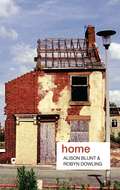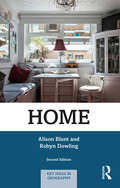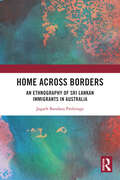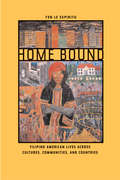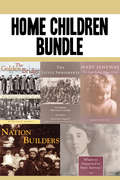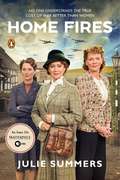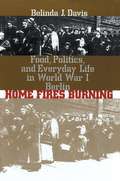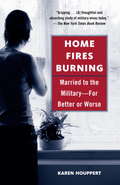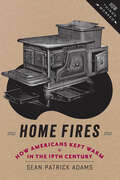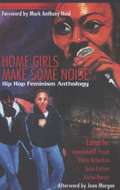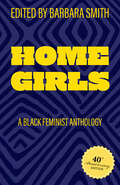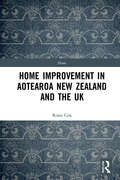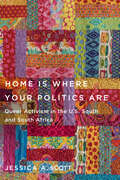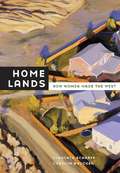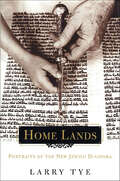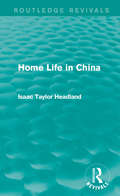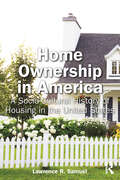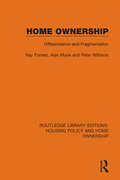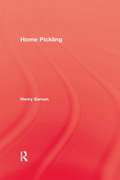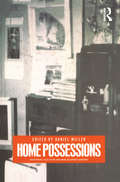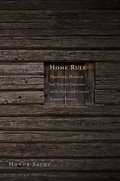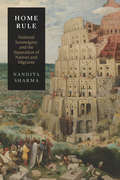- Table View
- List View
Home (Key Ideas in Geography)
by Alison Blunt Robyn Dowling‘Home’ is a significant geographical and social concept. It is not only a three-dimensional structure, a shelter, but it is also a matrix of social relations and has wide symbolic and ideological meanings; home can be feelings of belonging or of alienation; feelings of home can be stretched across the world, connected to a nation or attached to a house; the spaces and imaginaries of home are central to the construction of people’s identities. An essential guide to studying home and domesticity, this book locates ‘home’ within wider traditions of thought. It analyzes different sources, methods and examples in both historical and contemporary contexts; ranging from homes on the American frontier and imperial domesticity in British India, to Australian suburbs, multicultural London, and South Asian diasporic homes. The core argument of the book has three main parts that cut across each of its chapters: home-making identity and belonging homely and unhomely spaces. Each chapter includes text boxes and exercises and is well illustrated with cartoons, line drawings, and photographs. Outlining the social relations shaping, (and being influenced by) the geographies of home; and the imaginative as well as material importance of home, this book will be a valuable reference for students of geography, sociology, gender studies, and those interested in the home and domesticity.
Home (Key Ideas in Geography)
by Alison Blunt Robyn DowlingHome articulates a ‘critical geography of home’ in which home is understood as an emotive place and spatial imaginary that encompasses lived experiences of everyday, domestic life alongside a wider, and often contested, sense of being and belonging in the world. Engaging with the burgeoning cross-disciplinary interest in home since the first edition was published, this significantly revised and updated second edition contains new research boxes, illustrations, and contemporary examples throughout. It also adds a new chapter on ‘Home and the City’ that extends the scalar understanding of home to the urban. The book develops the conceptual and methodological underpinnings of a critical geography of home, drawing on key feminist, postcolonial, and housing thinkers as well as contemporary methodological currents in non-representational thinking and performance. The book’s chapters consider the making and unmaking of home across the domestic scale – house-as-home; the urban – city-as-home; national – nation-as-home; and homemaking in relation to transnational migration and diaspora. Each chapter includes illustrative examples from diverse geographical contexts and historical time periods. Chapters also address some of the key cross-cutting dimensions of home across these scales, including digital connectivity, art and performance, more-than-human constructions of home, and violence and dispossession. The book ends with a research agenda for home in a world of COVID-19. The book provides an understanding of home that has three intersecting dimensions: that material and imaginative geographies of home are closely intertwined; that home, power, and identity are intimately linked; and that geographies of home are multi-scalar. This framework, the examples used to illustrate it, and the intended audience of academics and students across the humanities and social sciences will together shape the field of home studies into the future.
Home Across Borders: An Ethnography of Sri Lankan Immigrants in Australia
by Jagath Bandara PathirageThis book studies how transnational migrants create a sense of home in their host countries. It draws on case studies of Sri Lankan migrants living in Australia to argue that 'home' is an existential experience rather than a fixed entity. The author looks at how the sense of home arises as a fresh category which is critical in defining one’s existentiality in the host society.Going beyond the conventional methodological approach of an ethnographer objectivizing other’s sense of home into fixed categories, the book attempts to foreground the immigrant’s articulation of home which evolves parallel to their being. It reveals how three important aspects of our lives – time, space and memory – intersect with the trajectories of migration. The author also delves into the ways in which migrants engage in building a home as a way of creating materiality in their dwelling practice.Unique and compelling, the book will be highly useful in studies of diaspora, globalisation and transnational migration. It will be of interest to students, researchers and scholars of anthropology, migration and transnational studies, as well as sociology and other related disciplines.
Home Away from Home: Japanese Corporate Wives in the United States
by Sawa KurotaniDrawing attention to domestic space as the critical juncture between the global and the local, Home Away from Home is an innovative ethnography of the daily lives of middle-class Japanese housewives who accompany their husbands on temporary corporate job assignments in the United States. These women are charged with the task of creating and maintaining restful Japanese homes in a foreign environment so that their husbands are able to remain productive, loyal workers for Japanese multinationals and their children are properly socialized and educated as Japanese citizens abroad. Arguing that the homemaking components of transnational communities have not received adequate attention, Sawa Kurotani demonstrates how gender dynamics and the politics of the domestic sphere are integral to understanding national identity and transnational mobility.Kurotani interviewed and spent time with more than 120 women in three U.S. locations with sizable expatriate Japanese communities: Centerville, a pseudonymous Midwestern town; the New York metropolitan area; and North Carolina's Research Triangle area. She highlights the contradictory situations faced by the transient wives. Their husbands' assignments in the United States typically last from three to five years, and they frequently emphasize the temporariness of their situation, referring to it as a "long vacation." Yet they are responsible for creating comfortable homes for their families, which necessitates producing a familiar and permanent environment. Kurotani looks at the dynamic friendships that develop among the wives and describes their feelings about returning to Japan. She conveys how their sense of themselves as Japanese women, of home, and of their relationships with family members are altered by their personal experiences of transnational homemaking.
Home Bound: Filipino American Lives Across Cultures, Communities, and Countries
by Yen Le EspirituFilipino Americans, who experience life in the United States as immigrants, colonized nationals, and racial minorities, have been little studied, though they are one of our largest immigrant groups. Based on her in-depth interviews with more than one hundred Filipinos in San Diego, California, Yen Le Espiritu investigates how Filipino women and men are transformed through the experience of migration, and how they in turn remake the social world around them. Her sensitive analysis reveals that Filipino Americans confront U.S. domestic racism and global power structures by living transnational lives that are shaped as much by literal and symbolic ties to the Philippines as they are by social, economic, and political realities in the United States. Espiritu deftly weaves vivid first-person narratives with larger social and historical contexts as she discovers the meaning of home, community, gender, and intergenerational relations among Filipinos. Among other topics, she explores the ways that female sexuality is defined in contradistinction to American mores and shows how this process becomes a way of opposing racial subjugation in this country. She also examines how Filipinos have integrated themselves into the American workplace and looks closely at the effects of colonialism.
Home Children Bundle: The Golden Bridge / The Little Immigrants / Mary Janeway / Nation Builders / Whatever Happened to Mary Janeway?
by Mary Pettit Gail H. Corbett Marjorie Kohli Kenneth BagnellIn the early years after Confederation in Canada, the rising nation needed workers that could take advantage of the abundant resources. Until the time of the Depression, 100,000 impoverished children from the British Isles were sent overseas by well-meaning philanthropists to solve the colony’s farm-labour shortage. They were known as the "home children," and they were lonely and frightened youngsters to whom a new life in Canada meant only hardship and abuse. This bundle of titles tells the entire story from many angles and in its many facets, from historical recounting, to genealogical information, to the personal story one such child, Mary Janeway. Includes: The Golden Bridge The Little Immigrants Mary Janeway Nation Builders Whatever Happened to Mary Janeway?
Home Fires
by Julie SummersSoon to be a PBS Masterpiece series starring Samantha Bond (Downton Abbey) and Francesca Annis (Cranford) Away from the frontlines of World War II, in towns and villages across Great Britain, ordinary women were playing a vital role in their country's war effort. As members of the Women's Institute, an organization with a presence in a third of Britain's villages, they ran canteens and knitted garments for troops, collected tons of rosehips and other herbs to replace medicines that couldn't be imported, and advised the government on issues ranging from evacuee housing to children's health to postwar reconstruction. But they are best known for making jam: from produce they grew on every available scrap of land, they produced twelve million pounds of jam and preserves to feed a hungry nation. Home Fires, Julie Summers's fascinating social history of the Women's Institute during the war (when its members included the future Queen Elizabeth II along with her mother and grandmother), provides the remarkable and inspiring true story behind the upcoming PBS Masterpiece series that will be sure to delight fans of Call the Midwife and Foyle's War. Through archival material and interviews with current and former Women's Institute members, Home Fires gives us an intimate look at life on the home front during World War II.From the Trade Paperback edition.
Home Fires Burning
by Belinda J. DavisChallenging assumptions about the separation of high politics and everyday life, Belinda Davis uncovers the important influence of the broad civilian populace--particularly poorer women--on German domestic and even military policy during World War I.As Britain's wartime blockade of goods to Central Europe increasingly squeezed the German food supply, public protests led by "women of little means" broke out in the streets of Berlin and other German cities. These "street scenes" riveted public attention and drew urban populations together across class lines to make formidable, apparently unified demands on the German state. Imperial authorities responded in unprecedented fashion in the interests of beleaguered consumers, interceding actively in food distribution and production. But officials' actions were far more effective in legitimating popular demands than in defending the state's right to rule. In the end, says Davis, this dynamic fundamentally reformulated relations between state and society and contributed to the state's downfall in 1918. Shedding new light on the Wilhelmine government, German subjects' role as political actors, and the influence of the war on the home front on the Weimar state and society, Home Fires Burning helps rewrite the political history of World War I Germany.
Home Fires Burning
by Karen HouppertAs taps echoes across the cookie-cutter housing areas of upstate New York’s Fort Drum, the wives turn on the evening news, both hoping for and dreading word of their husbands overseas. It’s a ritual played out on military bases across the nation as the waiting wives of Karen Houppert’s extraordinary new book endure a long, lonely, and difficult year with their husbands far from home. Houppert, a prize winning journalist, spent a year among these women, joining them as they had babies, raised families, ran Cub Scout troops, coached soccer–and went to funerals. The waiting wives include Lauren, twenty-six, whose Navy SEAL husband was killed in Afghanistan; Heidi, peace activist and Army wife whose life is a daily struggle with her conscience; Crystal, a nineteen-year-old raising two babies on a shoestring while her husband fights in the Middle East; Tabitha, who becomes the alleged victim of murderous domestic violence at the hands of her Special Operations boyfriend; and Danette, once an Army brat and now a devoted Air Force wife, who teaches, raises two teens, and fills her days with endless volunteer work. Houppert shows that these women make some of the same sacrifices of their personal liberties as their husbands do and yet garner none of the respect accorded their spouses. Today, these military wives find themselves torn between an entrenched tradition that would keep them in a Leave It to Beaver family ideal and a modern social climate suggesting that women are entitled to more–a career of their own, self-determination, and a true parenting partner. Meanwhile, the military concocts family-friendly policies and spends millions on new programs designed to appease military wives–and to maintain them as staunch supporters who will encourage their husbands’ reenlistment. The Army likes to say that it “recruits soldiers, but retains families. ” And indeed, the future of the all-volunteer force hinges on the success ofthismission. Though Army brass speak glowingly of the “Army Family Team,” this team is often deeply divided over strategy–and even goals. A gritty, behind-the-scenes look at the tour of duty from the domestic front, Home Fires Burning provides a fascinating, fresh look at an enormous American institution and the families that live in its shadow. From the Hardcover edition.
Home Fires: How Americans Kept Warm in the Nineteenth Century (How Things Worked)
by Sean Patrick AdamsHome heating networks during the Industrial Revolution helped create the modern dependence on fossil fuel energy in America.Home Fires tells the fascinating story of how changes in home heating over the nineteenth century spurred the growth of networks that helped remake American society. Sean Patrick Adams reconstructs the ways in which the "industrial hearth" appeared in American cities, the methods that entrepreneurs in home heating markets used to convince consumers that their product designs and fuel choices were superior, and how elite, middle-class, and poor Americans responded to these overtures.Adams depicts the problem of dwindling supplies of firewood and the search for alternatives; the hazards of cutting, digging, and drilling in the name of home heating; the trouble and expense of moving materials from place to place; the rise of steam power; the growth of an industrial economy; and questions of economic efficiency, at both the individual household and the regional level. Home Fires makes it clear that debates over energy sources, energy policy, and company profit margins have been around a long time.The challenge of staying warm in the industrializing North becomes a window into the complex world of energy transitions, economic change, and emerging consumerism. Readers will understand the struggles of urban families as they sought to adapt to the ever-changing nineteenth-century industrial landscape. This perspective allows a unique view of the development of an industrial society not just from the ground up but from the hearth up.
Home Fires: How Americans Kept Warm in the Nineteenth Century (How Things Worked)
by Sean Patrick Adams“Easily the most thorough and best-grounded account of the coal-based system of heating in the nineteenth-century United States . . . authoritative.” —The New England QuarterlyHome Fires tells the fascinating story of how changes in home heating over the nineteenth century spurred the growth of networks that helped remake American society. Sean Patrick Adams reconstructs the ways in which the “industrial hearth” appeared in American cities, the methods that entrepreneurs in home heating markets used to convince consumers that their product designs and fuel choices were superior, and how elite, middle-class, and poor Americans responded to these overtures.Adams depicts the problem of dwindling supplies of firewood and the search for alternatives; the hazards of cutting, digging, and drilling in the name of home heating; the trouble and expense of moving materials from place to place; the rise of steam power; the growth of an industrial economy; and questions of economic efficiency, at both the individual household and the regional level. Home Fires makes it clear that debates over energy sources, energy policy, and company profit margins have been around a long time.The challenge of staying warm in the industrializing North becomes a window into the complex world of energy transitions, economic change, and emerging consumerism. Readers will understand the struggles of urban families as they sought to adapt to the ever-changing nineteenth-century industrial landscape. This perspective allows a unique view of the development of an industrial society not just from the ground up but from the hearth up.“This smartly written and well-informed book focuses on a subject that very few people think about—the history of home heating in America.” —Choice
Home Girls Make Some Noise: Hip Hop Feminism Anthology
by Gwendolyn D. Pough Elaine Richardson Aisha Durham Rachel RaimistHome Girls Make Some Noise: Hip Hop Feminist Anthology seeks to complicate understandings of Hip Hop as a male space by including and identifying the women who were always involved with the culture. The anthology explores Hip Hop as a worldview, as an epistemology grounded in the experiences of communities of color under advanced capitalism, as a cultural site for rearticulating identity and sexual politics. With critical essays, cultural critiques, interviews, personal narratives, fiction, poetry, and artwork. The contributors are varied, from women working within the Hip Hop sphere, Hip Hop feminists and activists "on the ground," as well as scholars, writers, and journalists.
Home Girls, 40th Anniversary Edition: A Black Feminist Anthology
by Barbara Smith Alice Walker Audre Lorde June Jordan Alexis De Veaux Michelle Cliff Pat Parker Ann Allen Shockley Renita J. Weems Cheryl Clarke Becky Birtha Akasha Gloria Hull Toi Derricotte Luisah Teish Patricia Spears Jones Kate Rushin Bernice Johnson Reagon Tania Abdulahad Donna Allegra Barbara A. Banks Cenen Michelle T. Clinton Willi Willie Coleman Jewelle L. Gomez Raymina Y. Mays Deidre McCalla Chirlane McCray Linda C. Powell Spring Redd Gwendolyn Rogers Beverly Smith Shirley O. Steele Jameelah WaheedHome Girls, the pioneering anthology of Black feminist thought, features writing by Black feminist and lesbian activists on topics both provocative and profound. Since its initial publication in 1983, it has become an essential text on Black women's lives and contains work by many of feminism's foremost thinkers. This edition features an updated list of contributor biographies and an all-new preface that provides Barbara Smith the opportunity to look back on forty years of the struggle, as well as the influence the work in this book has had on generations of feminists. The preface from the previous Rutgers edition remains, as well as all of the original pieces, set in a fresh new package. Contributors: Tania Abdulahad, Donna Allegra, Barbara A. Banks, Becky Birtha, Cenen, Cheryl Clarke, Michelle Cliff, Michelle T. Clinton, Willi (Willie) M. Coleman, Toi Derricotte, Alexis De Veaux, Jewelle L. Gomez, Akasha (Gloria) Hull, Patricia Spears Jones, June Jordan, Audre Lorde, Raymina Y. Mays, Deidre McCalla, Chirlane McCray, Pat Parker, Linda C. Powell, Bernice Johnson Reagon, Spring Redd, Gwendolyn Rogers, Kate Rushin, Ann Allen Shockley, Barbara Smith, Beverly Smith, Shirley O. Steele, Luisah Teish, Jameelah Waheed, Alice Walker, and Renita J. Weems.
Home Improvement in Aotearoa New Zealand and the UK (Home)
by Rosie CoxThis book examines experiences of home improvement in the UK and Aotearoa New Zealand, providing valuable insight into the ways in which people make and maintain home in social, material and economic context. Drawing on in-depth interviews, examining both DIY projects and projects carried out by professional handymen, Rosie Cox explores how home improvement fits into wider social relationships and structures of inequality. Consideration is given to the importance of such work for gender and national identities, and how these identities are related to material contexts and the forms and fabric of homes. The book also highlights how home improvement can be a rewarding and valuable form of work, as well as an unrewarding and alienating endeavour. It will be of interest to scholars from a range of disciplines including anthropology, sociology and human geography.
Home Is Where Your Politics Are: Queer Activism in the U.S. South and South Africa
by Jessica A. ScottHome Is Where Your Politics Are is a transnational consideration of queer and trans activism in the US South and South Africa. Through ethnographic exploration of queer and trans activist work in both places, Jessica Scott paints a vibrant picture of what life is like in relation to a narrative that says that queer life is harder, if not impossible, in rural areas and on the African continent. The book asks questions like, what do activists in these places care about and how do stories about where they live get in the way of the life they envision for the queer and trans people for whom they advocate? Answers to these questions provide insight that only these activists have, into the complexity of locally based advocacy strategies in a globalized world.
Home Lands: How Women Made the West
by Virginia Scharff Carolyn Brucken.Home Lands: How Women Made the West upends the view to remember the West as a place of homes and habitations brought into being by the women who lived there.
Home Lands: Portraits of the New Jewish Diaspora
by Larry TyeThe idea for this book came to Larry Tye as he traveled overseas as a reporter for the Boston Globe. In each city he visited he was intrigued by a reawakening of practice and spirit of the long repressed Jewish community. And the more communities he saw close-up, the clearer it became to him that the Jewish world was being reshaped and revitalized in ways that were not reflected in what he was reading about the disappearing diaspora and the vanishing Jews of America.The result is Home Lands, an narrative that tells the story of the new Jewish diaspora. Tye picked seven Jewish communities from Boston to Buenos Aires and Dusseldorf to Dnepropetrovsk deep in the Ukraine, and in each he zeroes in on a single family or congregation whose tale reflects the wider community's history and current situation. He met each community's leaders, talked with their scores of young people and old, and went with them to High Holiday services and Sabbath celebrations.The first impression that emerges from his travels is each city's uniqueness. Far more striking than the differences, however, is the unity. Jews all over the world still have enough customs and rituals in common for outsiders to see them as part of the same people, and for them to define themselves that way. It is that new comfort level, that sense of finally feel comfortable in the lands where they are living, that is at the heart of this engrossing book. Readers' eyes will be opened to how Germany, just a generation after the genocide, has the world's fastest-growing Jewish population; how the Jews of Buenos Aires have carved a place for themselves in a land that also gave refuge to Nazi henchmen like Adolph Eichman, and how Ireland is home to a tight-knit Jewish community that, remarkably, has produced Jewish Lord Mayors in Belfast, Cork and, twice from the same family, in Dublin. In Boston, Tye tells the story of his own family, whose roots run deep in the city's Jewish community.Home Lands is a book that is deeply personal even as it sheds light on the larger Jewish experience.
Home Life in China (Routledge Revivals)
by Isaac Taylor HeadlandOriginally published in 1914, this text describes L.T. Headland and his wife’s experience in China in the early twentieth century. With a focus on home life this study explores issues such as children, marriage and education as well as food, religion and concubinage as well as presenting anecdotes and personal stories from the families Headland interacted with. This title will be of interest to students of Asian Studies and Anthropology.
Home Now: How 6000 Refugees Transformed an American Town
by Cynthia AndersonA moving chronicle of who belongs in America.Like so many American factory towns, Lewiston, Maine, thrived until its mill jobs disappeared and the young began leaving. But then the story unexpectedly veered: over the course of fifteen years, the city became home to thousands of African immigrants and, along the way, turned into one of the most Muslim towns in the US. Now about 6,000 of Lewiston's 36,000 inhabitants are refugees and asylum seekers, many of them Somali. Cynthia Anderson tells the story of this fractious yet resilient city near where she grew up, offering the unfolding drama of a community's reinvention--and humanizing some of the defining political issues in America today. In Lewiston, progress is real but precarious. Anderson takes the reader deep into the lives of both immigrants and lifelong Mainers: a single Muslim mom, an anti-Islamist activist, a Congolese asylum seeker, a Somali community leader. Their lives unfold in these pages as anti-immigrant sentiment rises across the US and national realities collide with those in Lewiston. Home Now gives a poignant account of America's evolving relationship with religion and race, and makes a sensitive yet powerful case for embracing change.
Home Ownership in America: A Socio-Cultural History of Housing in the United States
by Lawrence SamuelA wide-ranging cultural history centered around the concepts of real estate, the family home, and the American dream, and how they evolved over the years, Home Ownership in America: A Socio-Cultural History of Housing in the United States traces narratives around home ownership from the 1920s to today.As a product of the emergence of a large middle class during the Roaring Twenties, the modern concept of home ownership continued through the shaky Great Depression years, holding pattern of World War II, and glory days of the postwar era, when home ownership became a reality for much of the White middle class. While the late 1960s and 1970s were difficult years for home ownership as the postwar economic engine ran out of steam, a renaissance took place in the 1980s and 1990s due to tens of millions of baby boomers wanting to nest. Although there have been a few bumps in the road over the last couple of decades, home ownership, or at least the pursuit of it, is once again booming, making the subject as relevant as ever.With the single-family home central to the American idea and experience, this book touches on a host of issues related to our social divisions of race, gender, and class. Home Ownership in America is a truly interdisciplinary study, crossing over into a wide variety of subjects including sociology, family, urban history/planning, suburban studies, the built environment, public policy, business, finance, economics, politics, architecture, design, technology, and popular and consumer culture.
Home Ownership: Differentiation and Fragmentation
by Peter Williams Alan Murie Ray ForrestOriginally published in 1990 and drawing on extensive research, this book provides an evaluation of the impact of the growth of home ownership in the UK, and of the claims and counter-claims made for its social significance. The book examines critically the evidence for and against the proposition that mass home ownership is contributing towards a more equal society. Wide-ranging in its coverage, the book discusses the changing nature and role of home ownership, wealth accumulation and housing, the relationship between social class and housing tenure, and policy development.
Home Pickling
by Henry SarsonFirst published in 2005. Cooks eager to rediscover the lost culinary art of pickling will be weIl served by this fascinating and informative text, written by the founder of the best-known vinegar and pickling company in the United Kingdom. Beginning with an explanation of the history of pickling, principles and advantages, the book goes on to give detailed instructions on the preservation of artichokes, beans, beetroot, cabbage, shallots, tomatoes, peaches, cherries, a wide variety of chutneys and ketchups, meats and many other foods. Instructions are also given for mixing spices and determining correct levels of acidity and brine.
Home Possessions: Material Culture Behind Closed Doors
by Daniel MillerAlthough so much of the life we care about takes place at home, this private space often remains behind closed doors and is notoriously difficult for researchers to infiltrate. We may think it is just up to us to decorate, transform and construct our homes, but in this book we discover a new form of ‘estate agency', the active participation of the home and its material culture in the construction of our lives. What do the possessions people choose to take with them when moving say about who they are, and should we emphasize the mobility of a move or the stability of what movers take with them? How is the home an active partner in developing relationships? Why are our homes sometimes haunted by 'ghosts'?. This intriguing book is a rare behind-the-scenes exposé of the domestic sphere across a range of cultures. Examples come from working class housewives in Norway, a tribal society in Taiwan, a museum in London, tenants in Canada and students from Greece, to produce a genuinely comparative perspective based in every case on sustained fieldwork. So Japan, long thought to be a nation that idealizes uncluttered simplicity, is shown behind closed doors to harbour illicit pockets of disorganization, while the warmth inside Romanian apartments is used to expel the presence of the state. Representing a vital development in the study of material culture, this book clearly shows that we may think we possess our homes, but our homes are more likely to possess us.
Home Rule
by Honor SachsOn America's western frontier, myths of prosperity concealed the brutal conditions endured by women, slaves, orphans, and the poor. As poverty and unrest took root in eighteenth-century Kentucky, western lawmakers championed ideas about whiteness, manhood, and patriarchal authority to help stabilize a politically fractious frontier. Honor Sachs combines rigorous scholarship with an engaging narrative to examine how conditions in Kentucky facilitated the expansion of rights for white men in ways that would become a model for citizenship in the country as a whole. Endorsed by many prominent western historians, this groundbreaking work is a major contribution to frontier scholarship.
Home Rule: National Sovereignty and the Separation of Natives and Migrants
by Nandita SharmaIn Home Rule Nandita Sharma traces the historical formation and political separation of Natives and Migrants from the nineteenth century to the present to theorize the portrayal of Migrants as “colonial invaders.” The imperial-state category of Native, initially a mark of colonized status, has been revitalized in what Sharma terms the Postcolonial New World Order of nation-states. Under postcolonial rule, claims to autochthony—being the Native “people of a place”—are mobilized to define true national belonging. Consequently, Migrants—the quintessential “people out of place”—increasingly face exclusion, expulsion, or even extermination. This turn to autochthony has led to a hardening of nationalism(s). Criteria for political membership have shrunk, immigration controls have intensified, all while practices of expropriation and exploitation have expanded. Such politics exemplify the postcolonial politics of national sovereignty, a politics that Sharma sees as containing our dreams of decolonization. Home Rule rejects nationalisms and calls for the dissolution of the ruling categories of Native and Migrant so we can build a common, worldly place where our fundamental liberty to stay and move is realized.
